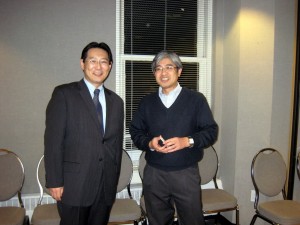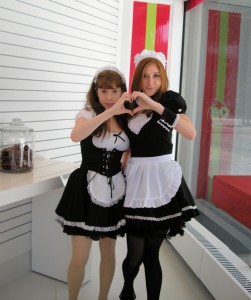Asahi Shimbun article on Andy Anderson and his family’s efforts to support Ishinomaki
************
Thanks to JET alum Mark Flanagan for sharing this article:
“Taking over a daughter’s dream to bridge Japan and U.S.”
By HIROSHI ITO / Correspondent
September 3, 2011
Andy Anderson never expected he would find himself trying to fill his daughter’s shoes by acting as a bridge between the United States and Japan.
But that all changed after his daughter, Taylor, perished in the massive tsunami spawned by the March 11 Great East Japan Earthquake.
Anderson, 53, a realtor living in Midlothian, in the suburbs of Richmond in the U.S. state of Virginia, is determined to continue the work that his 24-year-old daughter started.
Taylor had been teaching English to a handful of elementary and junior high schools in Ishinomaki, a coastal city in Miyagi Prefecture that bore the brunt of the tsunami that devastated the Tohoku region.
She has been working as a teaching assistant since August 2008 under the Japan Exchange and Teaching Program, a Japanese government initiative known as the JET program. Read More
JQ Magazine: JQ&A with JET Alum Mike Maher-King of Smile Kids Japan

"We are already talking to some universities and some private companies about Smile Kids Japan and soon I hope to have more volunteers than there are JETs in Japan! The JET network and support of AJET is at the very core of what we do."
By Renay Loper (Iwate-ken, 2006-07) for JQ magazine. Renay is a freelance writer and Associate Program Officer at the Japan Foundation Center for Global Partnership. Visit her blog at Atlas in Her Hand.
Mike Maher-King (Fukui-ken, 2006-11), originally from Shoreham-by-Sea, UK (near Brighton) and founder of Smile Kids Japan, which was created with the mission to have every orphanage in Japan visited regularly by a volunteer team in an effort to provide children with mentoring, cultural exchange and a newfound sense of trust.
Having making several Japanese friends while attending Royal Holloway, University of London, Mike eventually traveled to Japan and while there, fell in love with the people, the language, the culture, and most of all…the food! After working for a couple years in the UK, Mike returned to Japan as an ALT and eventually went on to create an organization that would touch the lives of thousands of Japanese children.
Recently, Mike took a few moments away from his hectic schedule to share with us a little about his organization, the emergence of volunteerism in Japan, and the impact the 3/11 earthquake and tsunami have had on his work.
When you first began Smile Kids Japan, did you realize you were introducing the concept of mentoring to the Japanese you were working with?
I didn’t actually realize that there are not as many opportunities for people to volunteer here in Japan as there are in the UK, USA, Canada. etc. until I started looking for a way to volunteer. I think with the cultural senpai-kohai (seniority based relationships) system here in Japan, the idea of mentoring isn’t at all new. However, this application of it is relatively new.
What challenges did you encounter doing volunteer work in Japan, where volunteerism isn’t as popular as it is in countries such as the UK or U.S.?
Setting up the very first meeting took a few months and lots of Japanese bureaucracy skills. But it was definitely worth the prodding! That and the initial 10 minutes of shyness, and walking into a room 1/4 of the size I expected with 10 more kids than we thought would choose to come meant all our planning wasn’t quite right! Further, it was also a little tricky to explain to some of the children’s homes what we wanted to do.
What do you think Smile Kids Japan has done for volunteerism in Japan?
There are so many people who do not realize the need for volunteers until they see it with their own eyes. I think that we are [now] approaching the tipping point. However, it is still a work in progress. We have provided an outlet for many people that want to help but didn’t have a channel for their energy. The [recent] earthquake initially transformed things with a huge amount of people volunteering. It will be interesting to see if this is carried back to people’s towns all around Japan.
***************
Ottawa based JET alum Brent Stirling (Fukushima-ken, Fukushima-shi, 2006-10) is one of only 2 Canadians out of 20 JET alumni selected to return to the Tohoku region to volunteer, engage and share their experience for the benefit of others, according to an article in the Ottawa Citizen.
(Note: This post previously repeated the error in the Ottawa Citizen article that Brent was the only Canadian participating. But it turns out that Toronto-based Tanya Gardecky (Miyagi-ken, Shiogama-shi) will also be participating.)
Stirling, who writes on his blog ForYourBrentertainment and was actively involved in the creation of Quakebook following the Tohoku Earthquake and Tsunami, submitted a proposal which was accepted by the program established by the Ministry of Foreign Affairs together with the Japan Tourism Agency to bring 20 Tohoku-area JET alums back to Tohoku to play a role in helping their communities and then spread word of their experience afterwards.
Read the full Ottawa Citizen article here: “Months of blogging leads to trip to Japan: Kanata teacher will help with disaster relief in the country he writes about”
Video: Panel discussion with JET alums Anthony Bianchi, Laurel Lukaszewski and Jim Gannon
Thanks to JET alum and Inuyama City Council Member Anthony Bianchi (Aichi-ken, Inuyama-shi, 1988-89) for sharing the video below (in four parts) taken by his son Matthew of a panel discussion from the JETAA USA National Conference held in Washington, D.C. July 14-17.
The panel featured Bianchi along with fellow JET alums Laurel Lukaszewski (Kagoshima-ken, 1990-92) (sculptor artist and former Executive Director of the Japan-America Society of Washington, D.C. as well as former President of Pacific Northwest JETAA) and Jim Gannon (Ehime-ken, 1992-94), Executive Director of the Japan Center for International Exchange (JCIE/USA), and was moderated by JETwit publisher Steven Horowitz (Aichi-ken, Kariya-shi, 1992-94).
Part 1
Part 2
Part 3
Part 4
Justin’s Japan: Interview with Billy Sheehan of Mr. Big on Touring Tohoku
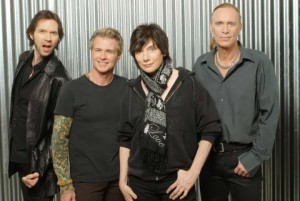
Billy Sheehan, right, with Mr. Big: "We had raised about $100,000 for the earthquake relief, and there’s still more to be raised, too. In the end, we raised a bunch of money, and we got a special letter from the Japanese Embassy in Washington, D.C. thanking us for being there." (William Hames)
By JQ magazine editor Justin Tedaldi (CIR Kobe-shi, 2001-02) for Examiner.com. Visit his page here for related stories.
One of the most respected bassists and gentlemen in the music world, Billy Sheehan is back with Mr. Big, the Los Angeles-based rock band he formed in 1988 best known for the hit ballad “To Be with You,” which shot to number one in 15 countries, including the U.S., in 1992. After splitting a decade later, in 2009 the original lineup reformed, followed by the release of What If…, the first album in 15 years from the original lineup.
Now, American fans are finally going to get a chance to see Billy, Paul Gilbert, Eric Martin and Pat Torpey together on stage since their ’90s heyday for a month-long American tour beginning Saturday (July 30) at San Diego’s 4th & B. In this exclusive interview, I spoke with Billy on Mr. Big’s current jaunt around the world, their triumphant return to Japan (where the band is revered), and the possibility of another album from the guys.
So far this year Mr. Big has played all over Europe, Asia and South America. What have your highlights been?
Japan is always amazing. The most difficult thing about touring is getting to and from the gigs…once we’re onstage, there’s no trouble at all, and in Japan, it’s just a breeze. We don’t fly in much, and take a lot of bullet trains, which are super convenient and easy and clean and safe and fast and everything. So Japan is always easy. The rest of Southeast Asia was actually pretty cool, too. We were supposed to do two shows in China, but the Shanghai show got cancelled because the promoters had the wrong visa for us. The shows in Korea, Taiwan and the Philippines were unbelievable, and in Taiwan we actually had to speed away from the venue in a van with literally crowds of people chasing after us (laughs). It was hilarious.
Mr. Big toured Japan less than one month after the earthquake and tsunami, and even did gigs in Iwate and Miyagi Prefectures, the areas most affected by the devastation. What was that experience like?
Really touching. There was a [camera] crew meeting us at the airport and then following us around, and we didn’t know, but they went out in the crowd and interviewed a lot of people, so later on we saw that they had interviewed a guy…I think he was from Sendai. They interviewed him for television, and we didn’t see it until we saw the show. He’d lost everything, and a couple of friends and family, and he’d lost his entire Mr. Big collection, so he actually came to the show to start his collection over again. And I’m telling you, it was so touching, this poor guy, that in his life, the important thing was to come and get his music back together again, really amazing. We had raised about $100,000 for the earthquake relief, and there’s still more to be raised, too—I just saw another $22,000, and I have to see what the figures are for the downloads of the special song we did [“The World Is on the Way”], also, so there’s a bunch more, too.
In the end, we raised a bunch of money, and we got a special letter from the Japanese Embassy in Washington, D.C. [signed by Ambassador Ichiro Fujisaki] thanking us for being there. We didn’t know how it would go when we went there, was it too soon or not, but [remember] after 9/11, where after the dust cleared, all the playhouses and restaurants were going out of business because nobody was going to New York City, so what helped was that going to see a show and having dinner to help the economy rolling again, so we were hoping to get that idea happening. We heard from saké dealers that were going out of business because nobody was drinking because they were all in mourning, you know? It’s a shame that so many lives were lost, but one of the most important things after anything like that is to get back up on your feet again. So I think we helped a bit—I’m cautiously optimistic to say I think we helped a bit. And from the tone of the e-mails and speaking with people after the show, we’re very pleased. So it all ended good.
Was there any hesitation at all about playing those gigs because of the radiation?
For me, no. A couple of the guys in the band were a little concerned about it. I fly transoceanic all the time [across] the Pacific, and you get a dose of radiation every time you do that. I think it’s equivalent to—I forget the figure—one, two or three chest X-rays just by flying over the ocean. And I do know that radiation, to incite fear in people, is almost second to none, you know? It’s invisible, and you don’t know it’s there and the next thing you know, you’ve got a problem. So I knew that there was probably some elevated degree of danger, but I also know that most things of that nature are over-exaggerated, in my experience with my own personal catastrophes of earthquakes and whatever else. They really do overblow it.
So I wasn’t worried personally, but we were more concerned for the fans, and I know that the Japanese government is very conscientious with their safety and rules. I remember I was in Tokyo one time, and there was a typhoon warning for everyone to stay inside. This was years ago, and I was out with a friend of mine, we were walking around, and the streets were deserted; there was nobody anywhere…the people in Japan are really in tune with the warnings and such. And I found out the government wouldn’t have allowed [us] to go on if we were to put a crowd of people in danger, so there was that factor, as well. So a couple of the guys in the band were a little worried about it, but I was okay with it, and in the end, all of us are glad we did it.
For the complete interview, click here.
For Justin’s February 2011 interview with Billy, click here.
MSNBC story and article feature volunteerAKITA and other JET volunteers
********************
Just saw this MSNBC video and article by NBC News correspondent Ian Williams that mentions JET and volunteerAKITA founder Paul Yoo as well as several other volunteers who seem to be JETs along with the good work being done by All Hands Volunteers. The article was posted to the Pacific Northwest JETAA Facebook group today.
“Young Americans take center stage in Japan tsunami cleanup”
http://www.msnbc.msn.com/id/43637669/
Visit msnbc.com for breaking news, world news, and news about the economy
Justin’s Japan: Interview with “Tokyo Vice” Author Jake Adelstein on Yakuza Films, Umbrellas
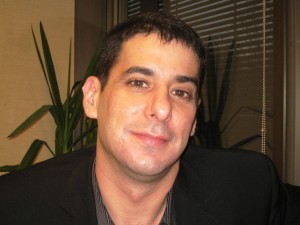
"I think the JET Program is a wonderful thing. Many people who have become scholars of Japan and have settled down in Japan begin on the JET Program. It is a wonderful way for the Japanese to get to understand Americans, and Americans to get to understand Japan." (Justin Tedaldi)
By JQ magazine editor Justin Tedaldi (CIR Kobe-shi, 2001-02) for Examiner.com. Visit his page here for related stories.
Examiner’s note: The following interview was conducted at New York’s Japan Society on March 10, 2011, hours before the Tohoku earthquake and tsunami would ravage eastern Japan. I was there to chat with guest lecturer Jake Adelstein, whose twelve-year career as a crime reporter for the Yomiuri Shinbun was chronicled in his acclaimed 2009 book Tokyo Vice. Adelstein is currently working on his second book, and as the editor of the Japan Subculture Research Center blog he continues to report on all the intriguing and seedy aspects that keep Japan running. In this exclusive interview, I spoke with Adelstein during an ominous cloudburst.
Thanks for meeting in this gloomy weather.
I used to like rainy weather, but my bodyguard, who’s an ex-yakuza, hates rainy weather. And I asked him once—I wish I hadn’t asked him—“What’s your deal with rainy weather? Why do you always not want to go out of the house and discourage me from going out?” And he’s like, “Oh, you know, when a yakuza kills another yakuza, they almost always do it on a rainy day, because first of all: bad visibility. The sound of the rain blurs the sounds of what’s going on, and the rain washes away all the trace evidence.” And ever since then, I haven’t been able to enjoy rainy weather as much as I used to.
I read that your birthday is coming up.
Well, let’s see. I’ll be 42. If all goes well, I will be ordained as a Soto Zen Buddhist priest on my birthday. I’ve got about a week of training left—if I could just remember that damn sutra. I had a talk with the priest and told him that I didn’t believe in the metaphysics of Buddhism, and he was like, “It’s all right. You just have to pretend that they’re true.” So as long as you uphold the precepts, it’s not belief; it’s deeds. I’m comfortable with that, the Episcopal King James version of Buddhism.
In an interview last year, you said you were going to have the opportunity to meet with yakuza boss Goto Tadamasa…
I might still have the opportunity, if he’s in good health. He’s been in and out of the hospital.
That’s his current status?
Yeah. He is still a priest. I’ve had some issues with his autobiography that was published last year, which had the equivalent of a yakuza fatwa on me. If you understand how the yakuza order people to be killed, you can read the lines very well. He refers to the attack on the director Itami Juzo in his memoirs and says, “Of course he deserved to be attacked, because he wrote a movie that was unpleasant about the yakuza,” and he refers to my writing as unpleasant. And then he has these two lines about, “I don’t know who this guy is, but even as an ex-yakuza, if I ever met him he would go from someone being targeted for death to someone being dead, ha-ha-ha.”
When a boss wants someone whacked in the yakuza, what he does is, he never gives an order, because then he could be held responsible. He just says, you know, “Johnson-san is a real pain in the ass; I don’t really like Johnson-san very well.” And his cohort immediately knows that he’s been asked to whack the guy. He whacks him and goes to jail, and comes out and gets a cash bonus from the organization. That’s how it’s done.
There’s talk that a film version of Tokyo Vice is in the works.
John Lesher, who produced No Country for Old Men, is signed on as the producer. There have been two or three actors who have expressed interest in playing the role. J.T. Rogers, who is a very good playwright—he’s got a play opening at Lincoln Center this year called Blood and Gifts—he is the principal screenwriter, and I am the co-writer. J.T. and I went to the same high school together. Actually, it’s interesting: he’s a very successful playwright, writes about Afghanistan and foreign countries. Peter Hessler, who is a China expert, he and I also hung out in high school at the same time.
What are your thoughts on the JET Program?
I think the JET Program is a wonderful thing. Many people who have become scholars of Japan and have settled down in Japan begin on the JET Program. It is a wonderful way for the Japanese to get to understand Americans, and Americans to get to understand Japan. Like any program, it has problems. I think it’s a great thing, and I hope it continues to be supported by both sides.
JQ Magazine: JQ&A with JET Alum Casey Novotny on the Documentary Film ‘100 Yen’
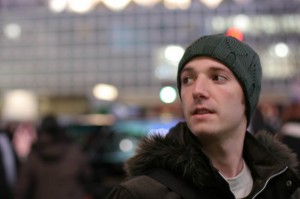
“I can definitely say I owe the experience that got me to this point to my time working as a CIR, and working with enthusiastic young students who want to study abroad during that time has motivated me to continue working in this field.” (Courtesy of Casey Novotny)
By Rick Ambrosio (Ibaraki-ken, 2006-08) for JQ magazine. Rick manages the JET Alumni Association of New York (JETAANY)’s Twitter page and is the creator of the JETwit column Tadaima!
Casey Novotny (Kochi-ken, 2005-08) gave us the inside scoop on 100 Yen, a film about the Japanese arcade scene coming this fall. Casey, who’s currently a program coordinator at Asia University in Tokyo, and director/JET alum Brad Crawford first met as JETs from Canada, and years later collaborated on this original project. Find out what inspired Casey and listen to his predictions for the future of the arcade scene.
How did you find yourself originally interested in Japan? Was it through games?
Yeah, I guess since when I was a child my interest in Japan started through video games, anime and such. The real thing that interested me those things, and thus Japan, was the gaping cultural differences. I really couldn’t grasp how the Japanese way of thinking could be so similar yet so different to ours. There was some weird stuff out there! I mean, there still is, but I think living here for over six years has kind of desensitized me to most of it.
How has Japan influenced your career and personal goals?
The first time I was an exchange student in Japan was when I was seventeen for half a year. That experience definitely changed my life, and I knew I wanted to make a career where I was going to use the Japanese language skills I was learning. At that point I wasn’t sure what kind of career, but I knew I had to improve my language skills and cultural understanding, and so I made a lot of my personal goals related to that. It seems I may be here for the long run, so it will probably continue that way!
How did your experience on JET lead you to where you are now?
I was a CIR in rural Kochi for three years. After enjoying life in the countryside and wanting to continue a similar career somewhere in Japan, I left for Tokyo and worked with a recruitment firm for more than a year and a half. It was a great experience and great place to work, but I realized that my place was with international education and exchange programs. I’ve been working with Asia University in Tokyo since then as a program coordinator for their America Program, which is the largest exchange program of its kind in Japan and probably one of the biggest in the world. I can definitely say I owe the experience that got me to this point to my time working as a CIR, and working with enthusiastic young students who want to study abroad during that time has motivated me to continue working in this field.
JQ Magazine: JQ&A with Masahiro Kozuma of the Japanese Children’s Society
By Stacy Smith (Kumamoto-ken CIR, 2000-03) for JQ magazine. Stacy is a professional writer/interpreter/translator. She starts her day by watching Fujisankei’s newscast in Japanese, and shares some of the interesting tidbits and trends together with her own observation in the periodic series WITLife.
At a gathering of the Battenkai, or Kyushu-ite group here in New York City, I had the pleasure of sharing a mirthful moment with Mr. Masahiro Kozuma. We were taking part in “laughter yoga” with the guest teacher at the event, who paired us up as partners with the task of performing a laughing exercise together. As we had just met this could have been a somewhat awkward activity to have to engage in, but thanks to Mr. Kozuma’s willingness I was able to ease into simulated laughter until it became real and I enjoyed the moment.
Later in the evening we continued our non-verbal communication with an actual conversation, where I learned that Mr. Kozuma serves as Director of the Japanese Children’s Society or New York Ikuei Gakuen (育英学園). This NPO established in 1979 provides Japanese education to youngsters with the motto of “Carefree Learning, Nurturing of Self-Training Children.” I had the chance to talk further with Mr. Kozuma about his background and that of his school.
What brought you to Battenkai?
I decided to join as I am from an area of Fukuoka Prefecture called Chikuhou. Fukuoka is blessed with beautiful nature like the mountains and the sea, and the Chikuhou region is known for coal mining. My childhood memories are of playing all the time on the huge heaps of coal waste that could be found around where I lived.
What was your path to the States?
While in Japan I got my master’s in Special Education, and I decided to come to here for further study in this field. In Japan the extent of my work experience was a part-time job at a fish store during university, but my first job here in the States was being an elementary school teacher at Japanese (supplemental study) school. I was also a counselor at their summer camp.
And now you work as director of Ikuei Gakuen, which has several schools throughout the New York area. Can you tell us a little about your system of education?
As director, I am in charge of all the schools which include the main Manhattan one, one in Port Washington, Long Island and the New Jersey campus where my office is located. Our curriculum is based on the standards set by the Ministry of Education in Japan, but it is bilingual learning as we have daily English classes. The subjects we cover are Japanese, English, math, science, social studies, music, arts and crafts, calligraphy and physical education. We also have special seasonal events like Field Day and school festivals. On the East Coast, we are the only full-time, integrated Japanese school for children ages 3 to 12.
In terms of supplemental study, we have Saturday and Sunday school as well for students who might attend regular school during the week, but still want to keep up with their Japanese education. We also do homeschooling for those who are unable to make the weekend classes.
Do you have to be Japanese to attend Ikuei Gakuen, or is it open to anyone? What is the procedure for getting in?
It is not limited to Japanese people, but the fact that classes are conducted in Japanese means that your language skills must be up to a certain level. We do have some students who are not from Japan, but who have one parent who is Japanese, etc. For all applicants we carry out screenings and a test, and provided they can pass and have developmental skills appropriate for their age they will be accepted. In circumstances where special individual treatment is necessary such as with learning disorders, we consider those on a case by case basis. Our school’s purpose is not preparing students for college entrance exams, as some might think.
Hibari-sensei: Seikima II Press Conference
Jen Wang (Miyagi, 2008-09) is a lab tech in Dallas and a staff writer for the Japanese music website Purple SKY. Her love of cosplay and her junior high school students inspired the name for her own Japanese pop culture blog, Hibari-sensei’s Classroom.
A-kon , Dallas, Texas’ longest-running anime convention, always bring interesting musical acts from Japan. This weekend, rock bands Blood Stain Child and D will be performing. At last year’s convention, I had the opportunity to attend a press conference with Seikima II. To celebrate their 25th anniversary, the heavy metal band reunited and embarked on the world tour, with Dallas as their first stop. The day after their high energy concert, or “black mass” as it is called among Seikima II fans, they sat down with reporters to answer questions about their music, goals, and efforts to spread both Japanese and akuma culture.
Your site says that you have returned with a new mission. What is your new mission?
Demon Kakka: To propagate ourselves throughout the world. We decided to have a reunion to see how the seeds of world domination have grown.
What made you decide to reunite and spread music to the U.S.?
Demon: There have been many offers, including collaboration with anime. We decided to use the popularity of anime to check out the scene in America.
Even though you claim to be devils, you seem like saints to me.
Demon: [in English] Devils, angels, saints, and Buddhas…I wonder what the difference really is between them. It all depends on what you think which is which.
Why did you choose to propagate Japanese culture?
Demon: The Japanese have a fascinating culture, but the people are not able to go out to spread it. If more Japanese could go out to spread their culture, there would be better communication.
Your songs have very vivid images and ideas. When you are writing lyrics, do you begin with an image, feeling, or story in mind?
Luke Takamura: A keyword is important. From there, the story comes. Sometimes, the melody comes first.
Jail O’Hashi: [in English] Recently I have been writing with Demon as a team. We think about what are things that can be expressed as Seikima II… pinpoint social and economic problems. Those things are important to be expressed in rock music.
Demon: Sometimes the melody is made and the lyrics come. Other times, I start with a story or notes. The ideas can from anywhere even people on the bus or train. When I’m riding the train, I’m in my human disguise so I can write lyrics without anyone knowing.
To read the rest of the interview, click here.
Justin’s Japan: Q&A with Grammy Award-Winning Musician Hiromi on ‘Voice’
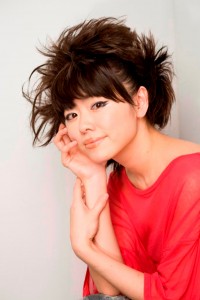
"I went back to Japan right after the earthquake and did a lot of live radio and TV shows to perform live to cheer people up. I just wanted to do something for the country I love and only thing I could do was keep playing music, so I kept playing." (Sakiko Nomura)
By JQ magazine editor Justin Tedaldi (CIR Kobe-shi, 2001-02) for Examiner.com. Visit his page here for related stories.
A native of Hamamatsu, Shizuoka, pianist and composer Hiromi Uehara is one of the world’s top young international performers in jazz, winning a Grammy earlier this year for her work on Stanley Clarke’s most recent album. Today (June 7), she releases Voice, her seventh studio effort since 2003 and first as part of the Trio Project with bassist Anthony Jackson (Paul Simon, the O’Jays, Steely Dan, Chick Corea) and drummer Simon Phillips (the Who, Judas Priest, David Gilmour, Jack Bruce).
“When I play music, I realize that it really filters emotions,” says Hiromi. “I called this album Voice because I believe that people’s real voices are expressed in their emotions.” Tonight, the Berklee College of Music alum launches a six-night residency at New York City’s venerable Blue Note Jazz Club as part of its inaugural Blue Note Jazz Festival. I caught up with the artist in this exclusive interview.
What kinds of goals in mind do you have when you record a new album? How about for a concert?
Making an album is like I have stories to tell; I want to see the landscape in music that I have never seen before. For a concert, I always think today is my first and last, trying to put everything I have out.
A big part of your style is your quicksilver runs across the keys. How did you develop this as your trademark, and are there ever times in concert when you feel like it’s a challenge to keep up that manic pace?
I never really thought about it as my trademark, I just play what I hear, what I have to say at that very moment, just like a conversation.
The toughest part of your job onstage that the audience might not realize is…
Definitely traveling.
I’ve noticed that you’ve been speaking a lot more English for interviews and at your concerts. Are you continuing to study it, and what kind of methods or techniques do you use that you can recommend to others who are learning a second language?
I do watch a lot of movies in English. Don’t be afraid to make mistakes, speak speak speak!
In what ways has the Japanese music community banded together in the wake of the earthquake and tsunami devastation? What has your impression been of the United States and its entertainers’ relief efforts?
I went back to Japan right after the earthquake and did a lot of live radio and TV shows to perform live to cheer people up. I also went back in April to do eighteen benefit shows in Tokyo. I just wanted to do something for the country I love and only thing I could do was keep playing music, so I kept playing. I really would like to thank everyone from the U.S. for their efforts. We surely need continuous support and I will keep doing whatever I can do.
For the rest of the interview, click here.

"I think it’s a gift to experience living in another culture, and if everyone in the world could have the chance to live in another country for a time, the world would probably be a better place." (Photo courtesy of the author)
By JQ magazine editor Justin Tedaldi (CIR Kobe-shi, 2001-02) for Examiner.com. Visit his page here for related stories.
A “certified mad Japanophile,” San Francisco-born and bred writer Wendy Nelson Tokunaga has lived her whole life in the Bay Area, save for a stint in Tokyo in the 1980s after winning a songwriting contest sponsored by Japan Victor Records. Since then, she has penned two Japan-related novels, Midori by Moonlight and Love in Translation.
Her new book, Marriage in Translation: Foreign Wife, Japanese Husband, is a series of illuminating interviews conducted by the author with Western women who talk candidly about the challenges in making cross-cultural marriages work both inside and outside Japan, and the joys and frustrations of adapting to a different culture. Tokunaga explores the theme of why some people feel the need to trade in their native culture for a new one, revealing new insights about Japan and married life. I caught up with the author in this exclusive interview.
What made you decide to write about this topic?
I’ve dated Japanese men and am now married to a Japanese born and raised in Osaka. I’ve always noticed how there are many more Western man/Japanese woman couples than the opposite. Even today, with the Internet and social media and the world shrinking, this pairing is still relatively rare and I think the reasons why are intriguing and fascinating.
The book originally started out as blog entries. When did you get the feeling that it deserved to be a book?
These series of interviews elicited a lot of interest from my blog readers and I got contacted by a couple of small publishers asking if I wanted to make it into a book.
Why did you choose to publish it as an eBook?
I’ve had experience with a traditional publisher, St. Martin’s Press, for my two novels, Midori by Moonlight and Love in Translation. I know how long it takes to get a traditional book published and I wanted to get this book out into the world while the interest was still high. I also wanted to dip my toe into the burgeoning world of eBook publishing and thought this would be a great opportunity.
The list price of $2.99 is certainly attractive. What’s your impression of the sales so far?
I think my sales have been pretty good thus far, especially when you take into consideration that I basically have only marketed this book via Twitter and by doing a bit of other online publicity. It’s a niche book for sure and I’ve also been donating 50% of the sales to Japan Relief. I certainly am not in it for the money!
You said that your husband Manabu felt he never “fit in” in Japan. Would you say this is a common trait among Japanese men who settle down outside of their home countries or cultures? Do you think this might hold less true for Americans who move to Japan?
This is another big question! I don’t have statistics to prove this, but through my own anecdotal evidence and observations over the years I have found that not many Japanese end up moving abroad permanently. There are many reasons for this. First, they don’t have the economic issues that many other immigrants face, and of course there is the tendency to feel that Japanese society is “unique” and can’t be duplicated anywhere else, so why leave?
So I would assume that for a Japanese man to move away from Japan there has to be some pretty compelling reason, especially since they also don’t tend to marry foreign women (though in Japan there are more Japanese men married to non-Japanese than Japanese women married to non-Japanese men. However, these women are usually of Asian ethnicity).
As you probably well know, an American man’s experience in Japan is often quite different. He can be seen as exotic and desirable (at least in the honeymoon stage of his stay) and even though he might undergo a lot of culture shock, things can be quite comfortable for him. Of course I have no choice but to generalize, but I have to say that the differences in experiences between an American man moving to Japan and a Japanese man moving to America couldn’t be more striking. There is nothing special about a Japanese man here in the States, but a gaijin in Japan still causes excitement to this day. On the other hand, to briefly open another topic, we certainly know of the quite different reasons why Japanese women would want to leave Japan. I explore that theme in Midori by Moonlight.
At least one of the interviewees served as a participant of Japan’s global exchange initiative, the JET Program. Tell us about the personal value of living in another country as a young adult compared with being a bit older and moving there with the intention to raise a family.
Well, for one thing a person coming to Japan on the JET Program is usually only going to be in Japan on a temporary basis and, from what I understand, the program purposely hires people who know little about Japan. So they come with no expectations and quite often leave with a wonderful experience. The Western woman coming to Japan to raise a family with her Japanese husband is in a much different situation. And I think the experience will have its differences whether she has been interested in Japanese culture all along or only came into contact with it by meeting her husband abroad. Either way, I think it’s a gift to experience living in another culture and if everyone in the world could have the chance to live in another country for a time, the world would probably be a better place.
JQ Magazine: JQ&A with JET Alum Robert A. Fish, Japan Society’s Director of Education and Lecture Programs
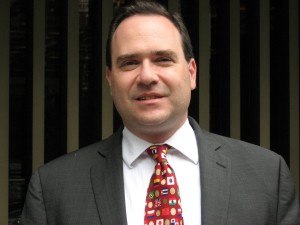
"I applied to the JET Program after three years of high school teaching. The Japanese public education system was held in high esteem at the time and I also felt that I could learn something from the 'gold standard' of educational systems."
By Lyle Sylvander (Yokohama-shi, 2001-02) for JQ magazine. Lyle is entering a master’s program at the School of International and Public Affairs at Columbia University (MIA 2013) and has been writing for the JET Alumni Association since 2004. He is also the goalkeeper for FC Japan, a NYC-based soccer team.
JET alumn Robert Fish (Wakayama-ken, 1996-97) joined New York’s Japan Society in May 2006 as Director of Education and Lecture Programs. Fish previously served as an Assistant Professor of East Asian history at Indiana State University, where he worked extensively with pre-service teachers. Fish earned a BA in History at Yale University, an MA in Educational Administration at New York University, and a Ph.D. in Japanese History at the University of Hawaii at Manoa.
His research focuses on the history of childhood and education in 20th century Japan, and includes a book manuscript near completion about the history of “mixed-blood” orphans in postwar Japan as well as publications regarding the history “textbook controversy” in Japan.
Tell us about your background.
I studied History at Yale University and taught World History East at my secondary school alma mater, Tenafly High School, in Bergen County, New Jersey. At that time, I didn’t have a strong knowledge base in the region and wanted to learn more about Japan, so I applied to the JET Program after three years of high school teaching. Plus, the Japanese public education system was held in high esteem at the time and I also felt that I could learn something from the “gold standard” of educational systems.
I spent one year teaching English in Wakayama and then enrolled in a Ph.D. program in Japanese History at the University of Hawaii, Manoa. After graduating, I saw two strong career possibilities. One was to go back to teaching at secondary schools, and the second was to pursue a path in academia. I chose the academic one and spent a year teaching at Michigan State University and then Indiana State University, where I was on a tenure track.
Why did you leave academia?
I enjoyed teaching, writing and doing research in Japanese history, but I felt that this opportunity allowed me to develop a real passion of mine: to help primary and secondary teachers teach Japanese history and culture.
Tell us about your current job.
The primary goal is to help teachers teach more effectively about Japan at the national level. Secondly, we help children learn directly through social networking—we promote children to children connections between the United States and Japan. Third, we introduce children to Japan through family programming.
JetWit Fashion Beat: T-shitsu – The Black Collection
JetWit Fashion Beat is brought to you by Dipika Soni (Ishikawa-ken, 2003-06). Dipika has recently moved back to London as is currently looking for new work opportunities related to Japan, translation, or other fields. She is also the former vocalist for the Japanese hardcore punk band DEGRADE.
——————————————————————————————————————————–
I first posted about T-shitsu and their fantastic designs aimed especially for gai-jin in December last year. Since then the response from members of the JET and JET alum community has been very positive, and the base of returning customers is constantly growing.
This is completely down to the unique omoshiroi designs, high-quality shirts and general high standard of service provided by the T-shitsu team. I can’t rave about these shirts enough!
Currently, our friends at T-shitsu.com are half way through revealing their eagerly anticipated Black Collection.
The Black Collection consists of 8 new designs, one of which is revealed every Sunday, May through June, and we have been given an exclusive sneak preview of this week’s new design especially for JETWit readers….
Ta da!!!
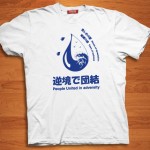 To update you on other recent activities, T-shitsu were very active in wake of the Tohoku eathquake/tsunami disaster in terms of fundraising and encouraging donations. They even designed their own t-shirt to raise money and awareness, called Tohoku Tears, a wonderful design that was distributed through their partner website at Sweatshop Union.
To update you on other recent activities, T-shitsu were very active in wake of the Tohoku eathquake/tsunami disaster in terms of fundraising and encouraging donations. They even designed their own t-shirt to raise money and awareness, called Tohoku Tears, a wonderful design that was distributed through their partner website at Sweatshop Union.
The Tokoku Tears shirt was extremely popular and all shirts sold out in A WEEK! In total the shirt raised an outstanding 300,000 yen. Since then all other designs in the ‘rebuild’ collection have also sold out, but if there are plans to re-release them we will be sure to let you know.
There will be further new releases on T-shitsu.com once The Black Collection finishes, and present designs will be made available in a wider selection of colours. There will also be further promotions and competitions, all of which will be advertised through the T-shitsu Facebook site. Make sure you sign up for all the latest info, and it’s also a great way to contact the designers with your feedback and suggestions for shirts.
Please do post any comments/suggestions about the shirts, in particular any JET-related shirt ideas, and please do inform the T-shitsu team that you heard about them through JETWit if you place any orders. Check back for more updates soon!
Have a suggestion for a future JetWit Fashion Beat post? E-mail dipika [at] jetwit.com.
Hibari-sensei: Interview with Neko Neko Maid and Host Club
Jen Wang (Miyagi, 2008-09) is a lab tech in Dallas and a staff writer for the Japanese music website Purple SKY. Her love of cosplay and her junior high school students inspired the name for her own Japanese pop culture blog, Hibari-sensei’s Classroom.
Neko Neko Maid and Host Club (originally the Neko Neko Maid and Hostess Club) is a traveling maid troupe that makes appearances at anime conventions across the country. Unlike most anime con maid cafes, which consist of cosplayers serving food, Neko Neko brings the interactive experience integral to Akihabara maid culture to its guests. The girls (and guys) make small talk and play games with guests and sing and dance to J-pop songs.
The club is ready to kick off its 2011 tour with an appearance at Comicpalooza in Houston, Texas this weekend. Then they will be at Dallas’ anime convention, A-kon, from June 10-12. I was introduced to Neko Neko at last year’s A-kon, and I had a chance to sit down with one of its founders and maid leader Kitti Maherin and maid assistant Minami to learn more about the club.
How did Neko Neko get started?
Kitti: We formed on July 4, 2009. It started as four girls who enjoy maid cafes. When I went to Japan, I fell in love with the maid café I visited in Akihabara.
What made you decide to focus on the performance aspect rather than serving food in cosplay like other maid cafes at conventions?
Kitti: I enjoy performing, and it was a low cost option.
Who decides on the music you dance and sing to?
Kitti: The maid leaders and assistants choose the music. Miki, our choreographer and another founder, has a lot of input.
How long do you practice your dances?
Minami: It depends on the dance.
Kitti: I practice every day.
To read the rest of the interview, click here.



